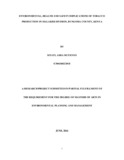| dc.description.abstract | Tobacco has existed since prehistoric times and is now widely grown as a cash crop in developing countries like Kenya. The number of tobacco farmers contracted by tobacco companies in Kenya increased by 67% in the period 1972 to 1991 and by 36% from 1991 to 2000. Though the industry is lucrative to most tobacco farmers due to ready markets and loans, tobacco production substantially contributes to environmental degradation and increased health and safety risks to farmers and workers. Tobacco farming practices also pose a challenge for environmental sustainability due to increased deforestation, over-application of agrochemicals and subsequent pollution.
In the process of farming, tobacco farmers are exposed to a number of occupational health and safety risks characterized by many physical, chemical, and biological hazards. Nicotine poisoning is one of the health-related complications that results from farmers’ regular contact with wet tobacco leaves. Tobacco crops require constant application of agrochemicals due to their susceptibility to pests and other diseases. This frequent exposure to chemicals increases the vulnerability of farmers to health related risks. During tobacco curing, farmers are exposed to risks of physical injuries caused by fire.
This study, therefore, seeks to achieve a number of objectives: to investigate how tobacco production contributes to environmental degradation; to assess the level of environmental awareness among tobacco farmers in tobacco production; to determine the prevalence of risk factors among tobacco farmers; and to identify strategies that can help reduce the environmental impact and health and safety risks in tobacco production. A total of 100 tobacco and non-tobacco farming households were sampled for the study. Key informant interviews were also conducted
targeting the local leadership, focal persons at the two tobacco companies, extension services officials and medical practitioners based in Malakisi. Focus group discussions (FGDs) were undertaken in four groups targeting both tobacco and non-tobacco farmers based on age, gender, and experience in farming.
The study found that tobacco production that has extensively led to deforestation in the area. Indigenous trees have been cut down, and the reforestation programmes are not effective. Consequently, the rivers that were once permanent have become seasonal. The quality of soil on tobacco farms has deteriorated over time due to over-utilization of chemicals and fertilizers. The health of tobacco farmers and workers has always been at risk as the use of Personal Protective Equipment (PPE) is not always practiced. The farmers have had a range of symptoms that point to Green Tobacco Sickness (GTS). Physical injuries were also reported among family members. Besides the risk factors, tobacco farmers remain unaware of the rules and regulations governing the tobacco production process. However, there exist a proportion of tobacco farmers who are familiar with the rules but they don’t follow them to the letter. Most farmers are largely ignorant of the risks that they are exposed to.
The study, therefore, recommends that tobacco farmers be regularly trained on farming and conservation best practices. Effective reforestation programmes, proper waste disposal practices and use of PPEs can significantly reduce the impact on tobacco production. Tobacco companies can also play a crucial role in the form of corporate social responsibility that promote initiatives that would lead to a sustainable environment with minimal risks to health and safety of farmers. The laws on tobacco control, which are biased towards tobacco smoking, need to be reinforced to include tobacco farming related provisions. Setting targets for tobacco companies, in terms of
environmental conservation and safety of farmers, could enhance sustainable practices in the tobacco production process. | en_US |



